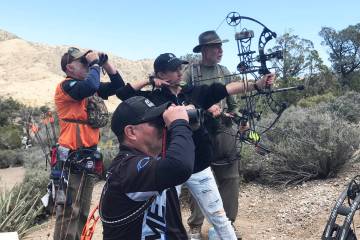Tube techniques aren’t luring many fish for this angler
It was almost time to go home when I finally managed to set the hook on one of Lake Mohave’s smallmouth bass while throwing a tube bait. “Lunker” or “monster” are not the words an honest fisherman would use to describe the fish, not until it grew awhile longer anyway, but it was a smallmouth and he had taken my tube bait. A hard-earned victory of sorts.
Perhaps in another year or two this story will grow into a whopper.
My friend Roger and I had left town well before light so we could beat the Memorial Day weekend rush at the launch ramp. We did just that, but from the number of vehicles and boat trailers already in the parking lot when we arrived at Cottonwood Cove, we knew the reservoir would not be ours alone.
The night before, I had made a last-minute trip to the sporting goods store to pick up a few things for the day. I went specifically to get some tube baits and jig heads but came back with much more. It would seem that last-minute trips to the sporting goods store are a lot like making a grocery store run when you’re hungry. Everything looks good. But it’s not until you try to squeeze the new stuff into the pockets and corners of your tackle box that you realize how much stuff you already own but have yet to use.
You also find stuff you forgot you had in the first place. Like a bag of tubes in the exact size and color I was looking for on that last-minute trip to the store.
To avoid the full brunt of expected winds, we spent the day working coves in the central part of Lake Mohave. As usual, Roger caught fish and I went to school. Though we threw the occasional spinnerbait or drop shot, most of the time we worked the bottom with tubes. The fish seemed to ignore mine.
By the end of the day, I had managed to bring only two fish all the way to the boat. Neither was deserving of a photo op, but they were fish. In the days since, I have thought about the things I learned Saturday. Though experience is often the most effective teacher, I opted to spend some time reading up on tube baits. One of the things I learned is that every pro angler or fishing writer has a different take on how to fish a tube.
Tube baits are simply that, a plastic tube that is open at the back and closed at the front. Surrounding the opening is a fringe that resembles tentacles and adds extra motion to the bait when it is in the water. Tubes first showed up on the bass fishing scene in about 1980, the brainchild of brothers Gary and Bobby Garland, who both started out in the bait business by designing and producing plastic baits to catch crappie.
Originally marketed as “The Fat Gitzit,” the tube concept came about as the brothers looked for a way to fool bass in the clear waters of Lake Mead and other western impoundments. By 1981, Bobby was named the Western Bass Fishing Association Angler of the Year, and it wasn’t long before western anglers took to the new bait.
As with all things that catch fish, the Gitzit soon made its way into the hands of some of the big names of the day, and the rest is history. The bait caught fish, and according to an early ad, here is why it works:
“Bass strike by sight and sound. The Gitzit is the size of most bass forage such as small blue gill, shad and crawfish. ... Most strikes come on the fall with this bait. Every bait falling or moving through the water has its own sound. A bass either rejects or strikes a bait according to its action, appearance and sound.”
Today’s fishing writers seem to agree. Though their words are different, the description as to why the tube works is essentially the same. It all boils down to the movement of the tube underwater, movement that can be adjusted by using various rigging methods and hook options. How a tube is rigged is really up to the creativity of the individual angler.
The key is learning to picture what your tube is doing under the water as you work it along the bottom and asking the question, “If I were a fish, would I take the bait?”
If not, then it might be time to change what you are doing. In my case, it is not the casting of my bait that is an issue, though my accuracy could use some work. Fish must not like my tube presentation, the bait’s action underwater.
Darn the bad luck. Guess I’ll have to sacrifice and do some more fishing ... um, research.
Freelance writer Doug Nielsen is a conservation educator for the Nevada Department of Wildlife. His “In the Outdoors” column, published Thursday in the Las Vegas Review-Journal, is not affiliated with or endorsed by the NDOW. Any opinions he states in his column are his own. He can be reached at intheoutdoorslv@gmail.com.






















